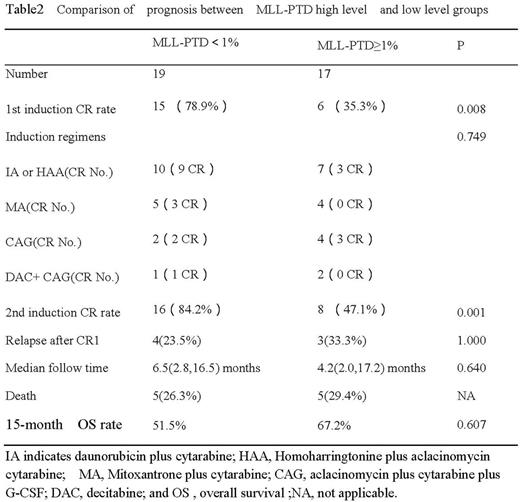Abstract
Genetic alterations of the mixed-lineage leukemia (MLL) gene are commonly implicated in the development of acute leukemia. In acute myeloid leukemia (AML), a partial tandem duplication (PTD) of MLL occurs in about 5%-11% of patients, mainly in adults and rarely inchildren( Meyer C et al Leukemia 2013) .It is not known whether the initial expression level of MLL-PTD affects the prognosis of AMLs. Therefore, we analyzed the clinical data of 36 AML patients with MLL-PTD treated in our institute from January 2014 to January 2016, and tried to investigate whether the initial level of MLL-PTD has an impact on the prognosis of AML patients.
MLL-PTD is present in adult non-leukemichematopoiesisand observed in bone marrow and peripheral blood of adult healthy individuals. In order to identify the threshold of MLL-PTD for AML patients, a control group of bone marrow samples from 29 normal adult donors were tested. The median value of MLL-PTD was 0.046(0.014¡«0.080)%. Patients with AML were considered MLL-PTD positive if their expression level was higher than 0.08%.
430 patients were newly diagnosed AML and treated in institute between January 2014 and January 2016. Among these AML patients, AML patients with MLL-PTD were selected as the subject patients. The following inclusion criteria were applied: (1) more than 16 years old; (2)Bone marrow MLL-PTD/ABL£¾0.08%; (3)receivedmore than 2 cycles of chemotherapy. Our study was approved by the Ethics Committee of Peking UniversityPeople¡¯s Hospital.All patients offered signed informed consent to participate in the study.The cutoff date for follow-up was Match 31, 2016.
Of the 430 de novo AML patients, 36(8.4%) patients were MLL-PTD positive. The median age was 48(22¡«72) years. 28 cases were diagnosed M2, and the others included 4 cases of M4, 2 cases of M5 and 2 cases of M6. 5 cases were FLT3-ITD mutation+, 2 cases were NPM1 mutation+,7cases were double-CEBPA mutation+.
The complete remission (CR) rate after first induction chemotherapy was 58.3%, the total CR rate after second chemotherapy was 66.7%, 1 case achieved CR after third chemotherapy, and 1 case achieved CR withsorafenibtreatment. 2 cases receivedallo-HSCT. In the 26 cases who achieved CR1, 7 cases relapsed at a median of 5 months. The median follow-up was 4.8 (2¡«17.2) months, and 10 cases were died.
According to Hans B. Ommenetal¡äs study (Ommen HB et al Br J Haemato2014), ROC analysis was performed to determine the potential optimal MLL-PTD cutoff level to predict the incidence of CR after second induction chemotherapy. We established MLL-PTD ¡Ý1% as the cut of value. 19 cases were MLL-PTD £¼1% as the low level group and 17 cases were MLL-PTD ¡Ý1% as the high level group. Distribution of FAB type (M2 incidence 100% vs. 53%, P=0.003) and biallelic CEBPA mutation incidence (37% vs. 0%, P=0.008) were significantly different between the two groups. (Table 1) The CR rate after first induction chemotherapy (78.9% VS 35.3%, P=0.008) and CR rate after second induction chemotherapy (84.2% VS 47.1%,P=0.001) were also significantly different between the two groups.(Table 2) Logistic regression analysis showed that high level of MLL-PTD was the only independent risk factor of CR rate after second induction chemotherapy (OR=0.16, P=0.024). There were 5 patients died in each group. The 15-month estimated OS between low-level and high-level groups was not significantly different (51.5% vs .67.2%, P=0.607).
Our data indicates that the initial level of MLL-PTD in patients with AML affects clinical prognosis, and patients with high initial level MLL-PTD have a lower CR rate. Low level of MLL-PTD may not play a part in the development of acute leukemia. And it needs further observation to identify the effect of initial MLL-PTD level on survival.
Kong Jun and Jiang Hao contributed equally to this work
No relevant conflicts of interest to declare.
Author notes
Asterisk with author names denotes non-ASH members.



This feature is available to Subscribers Only
Sign In or Create an Account Close Modal